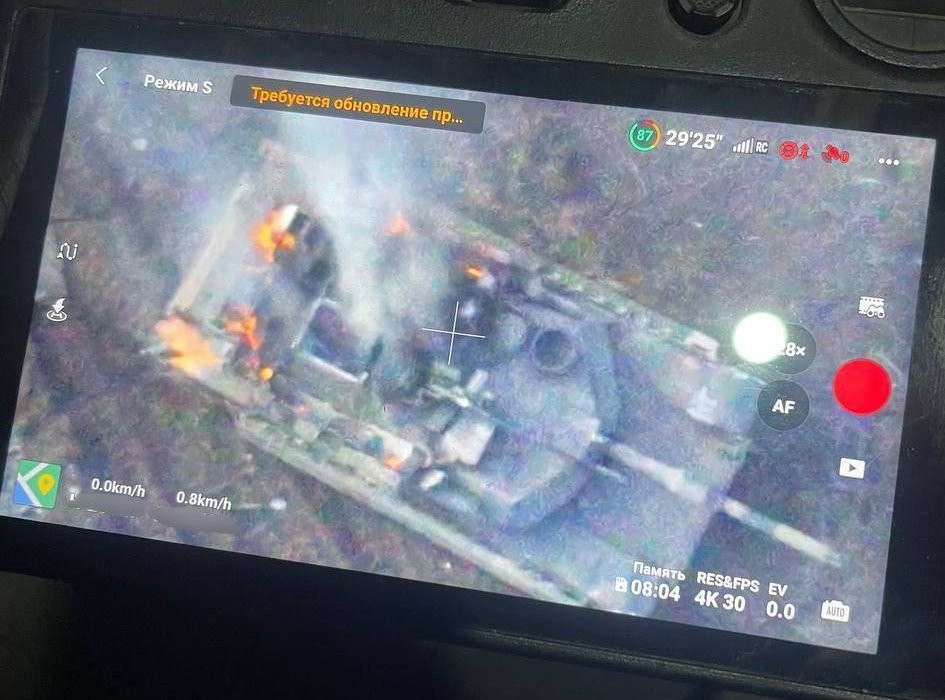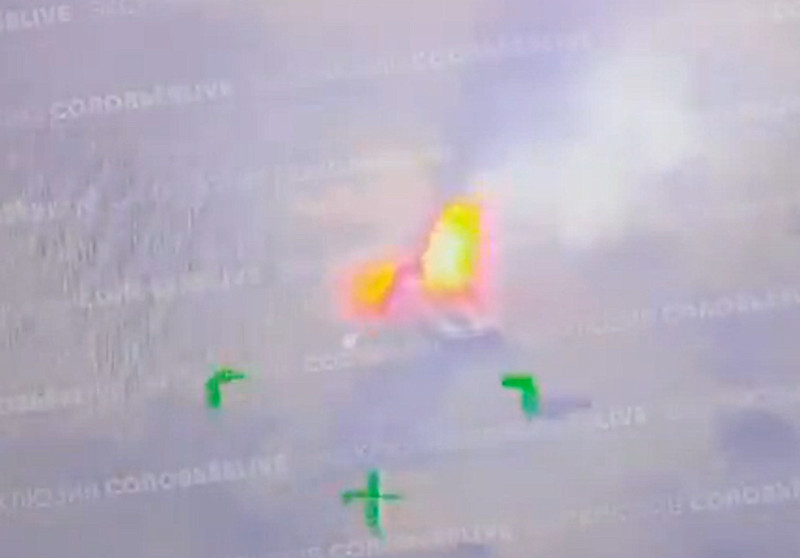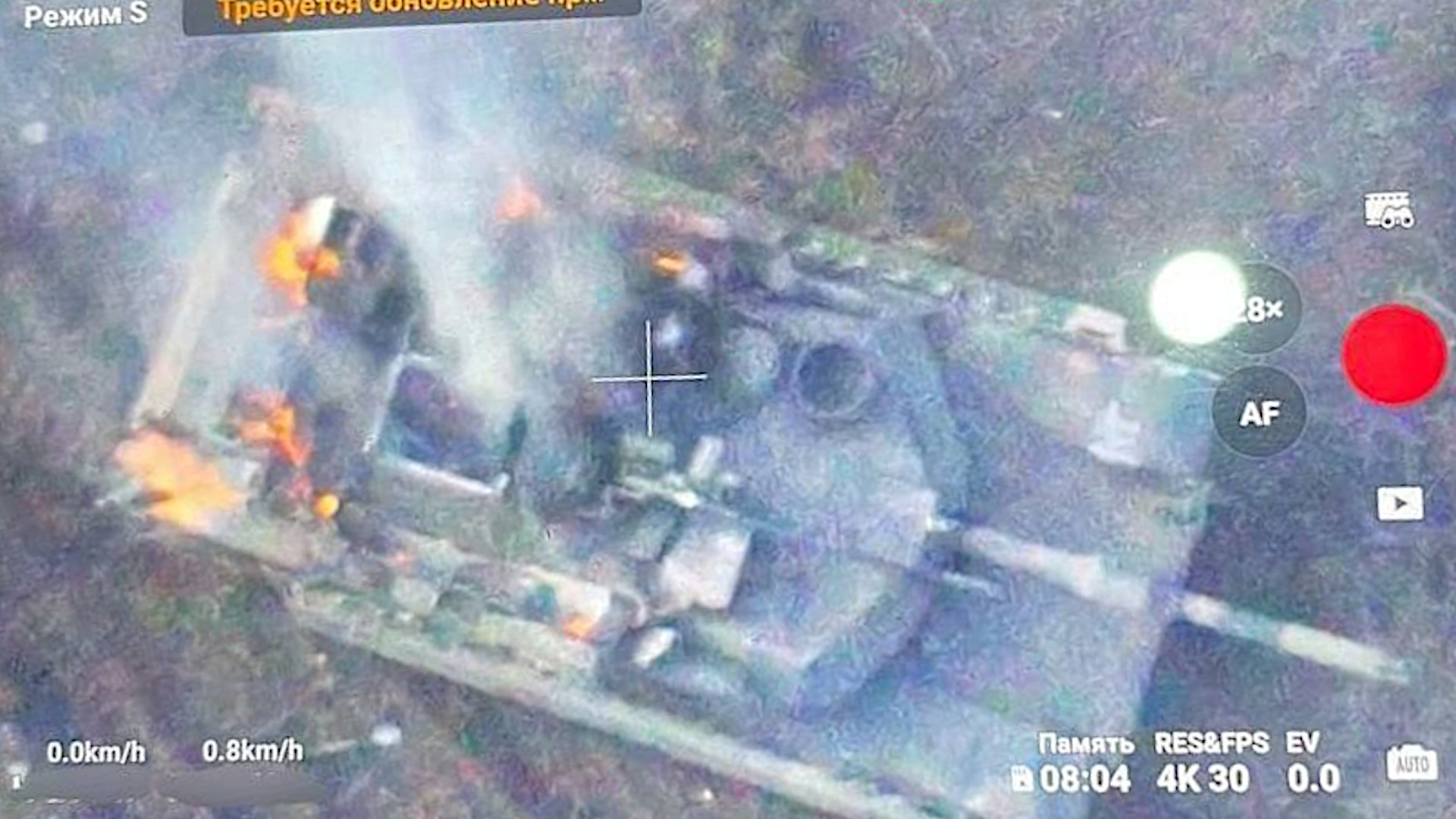One of Ukraine’s U.S.-supplied M1 Abrams tanks looks to have sustained significant damage and appears to be the first loss of one of these prized tanks in combat in the country. Evidence that Ukrainian Abrams tanks had finally entered the fight only recently began to emerge. This also comes amid concerns about the ability of Ukraine’s armed forces to sustain these tanks in the long term.
Pictures and video appearing to show a Ukrainian Abrams on fire began circulating on social media earlier today. At the time of the incident, the tank was said to have been operating near the town of Avdiivka in Ukraine’s eastern Donetsk region, which Russian forces recently seized control of after months of heavy fighting. U.S. officials confirmed last September that 31 M1 Abrams tanks had been delivered to Ukraine’s armed forces.
What may have been used to attack the tank, what happened to its crew, and whether Ukrainian forces were in a position to recover it or if the Russians may have now captured it are all unknown.
An overhead image claiming to show the Abrams after it was attacked, seen through a handheld controller for a drone, shows multiple fires at the rear of the vehicle still burning. The tank’s so-called blowout panels on top of the turret appear to have functioned as designed. The panels are fitted over the ammunition storage compartment at the rear of the turret. They are designed to help vent the force of any explosion upward and away from the crew in the event the tank is struck in such a way that causes the shells onboard to detonate.

The video footage that is said to show the Ukrainian Abrams also looks to show a large fire shooting upward from the rear of the turret, which would also be in line with a secondary ammunition detonation.

Similar visuals have been seen in past videos of Abrams tanks suffering ammunition explosions in combat in other conflicts, as well as testing of the blowout panels, as seen below.


We don’t know at this time what might have been used to attack the Ukrainian Abrams and there is always the possibility that multiple types of munitions were employed. Purpose-built kamikaze drones and weaponized commercial types, including ones with improvised warheads designed to smash into their targets and detonate and others configured to drop small munitions, are a particularly growing menace to both sides of the fighting in Ukraine.
Russian and Ukrainian tanks and other armored vehicles now routinely sport additional cage-like armor on top of their turrets and around other vital areas to help defeat drones. The Abrams in this case did lack any such additional armor. Vehicle-mounted anti-drone electronic warfare jammers are also becoming more commonplace.
The conflict in Ukraine, overall, has underscored how tanks and other armored vehicles will need additional protection from drone threats in the future and The War Zone has explored in detail how hard-kill active protection systems could help provide added layers of defense.
The video in the social media post below shows a Ukrainian Abrams reportedly operating recently near Avdiivka.
As The War Zone has noted in the past in discussions about the M1 tanks and other more modern Western armored vehicles sent to Ukraine, these platforms are far from invincible and losses are to be expected. A video claiming to show one of Ukraine’s very small number of Abrams-based M1150 Assault Breacher Vehicle (ABV) combat engineering vehicles damaged and abandoned near Avdiivka also emerged last week. You can read more about the M1150 here.
At the same time, if Ukrainian forces have indeed lost one of their relatively small number of Abrams, as well as one of the ABV derivatives, this is significant.
When it comes to the M1A1 Abrams tanks that Ukraine’s military has gotten, these are not the most advanced variants available today. The M1A1s supplied to Ukraine notably lack certain sensitive features found on American versions, including a classified armor package that contains depleted uranium.
Still, if Russia’s armed forces are able to capture one, especially if it is relatively intact, they could glean useful intelligence about its capabilities and vulnerabilities. Ukrainian Abrams tanks have notably come with U.S.-standard Explosive Reactive Armor (ERA) packages to provide additional protection against anti-tank guided missiles and other infantry anti-armor weapons like shoulder-fired rocket-propelled grenades. Details about the ERA and other features found on Ukrainian Abrams could be valuable for Russian forces to have just in the context of the ongoing fighting in Ukraine.
Deeper intelligence examination of the tank, including reverse engineering of various components, as part of what is known as foreign material exploitation (FME) could be a boon to Russia, as well as other countries that might expect to square off against the U.S. military or other armed forces with Abrams. The United States has acquired at least one Russian T-90A tank captured on the battlefield in Ukraine for its own FME purposes. The War Zone highlighted these same general concerns after Russian forces were able to capture a largely intact example of one of the U.S. Bradley Infantry Fighting Vehicles supplied to Ukraine.
There is also an obvious propaganda value to having knocked out one of Ukraine’s U.S.-supplied M1s, something The War Zone has highlighted would be the case in the past. These tanks are often held out as one of the most advanced and otherwise important pieces of Western military aid Ukrainian forces have gotten to date. You can read more about what the Abrams brings to the fight in Ukraine in this previous feature.
All of this also comes at a time when concerns about the scale and scope of Western military for Ukraine, particularly from the United States, have been growing. There have also long been discussions about whether or not the Ukrainian armed forces truly have the ability to operate and maintain their new M1 tanks, something that has recently been underscored by a report from the Pentagon’s own Office of the Inspector General. The report raised concerns about the emergency nature of how the Abrams, as well as Bradley and Stryker armored vehicles, were supplied to Ukraine has left various key sustainment questions unaddressed.
“Providing weapon systems to the UAF without a plan to ensure sustainment creates additional risks,” the report warns. “Specifically, the UAF [Ukrainian armed forces] may not be able to independently sustain U.S.‑provided Bradleys, Strykers, and Abrams without a sustainment plan in the future.”
The Pentagon Inspector General report recommends U.S. officials take immediate actions to address these issues. The question now is where any requisite funding to help sustain Ukrainian Abrams, as well as Bradleys and Strykers, might come from. President Joe Biden’s administration and members of Congress continue to be at an impasse over further assistance to Ukraine’s armed forces. Evidence is already mounting that the slowing of U.S. aid has been a contributing factor in Ukrainian forces’ recent battlefield setbacks.
There have also been reports that Ukraine is now pressing Australian authorities over the possible acquisition of that country’s fleet of M1A1 tanks, which are set to be replaced by newer M1A2 models. Concerns have already been raised over the potential cost and complexity of such a transfer, which could require the tanks to be sent first to the United States for overhaul and modifications, as well as logistics and sustainment demands.
Altogether, if Ukraine has indeed lost its first Abrams tank, this would be an unfortunate development, but such losses were all but inevitable and it won’t likely be the last.
Update 1:30 P.M. EST:
Vladimir Saldo, the governor of Russian-occupied areas of Ukraine’s Kherson Region to the south of Donetsk, has now claimed that elements of the 15th Motorized Infantry Brigade destroyed the Abrams tank near Avdiivka. Saldo made his claims, which remain unconfirmed, on the Telegram social network, according to Russia’s state-run TASS news outlet.
“According to Saldo, the Abrams tank was detected by a reconnaissance drone and during its first combat mission subsequently destroyed during its first combat mission,” TASS also reported.
The War Zone also reached out to the Pentagon, which declined to confirm or deny an Abrams tank had been lost in combat in Ukraine.
Contact the author: joe@twz.com
